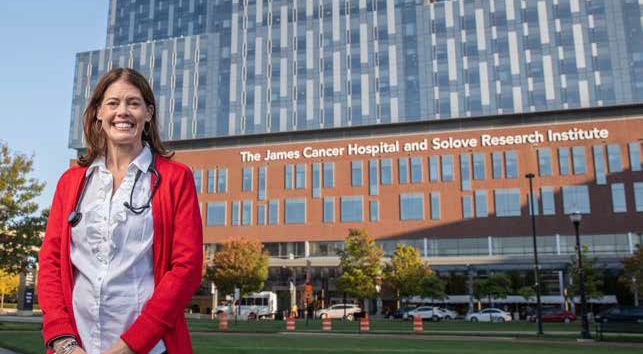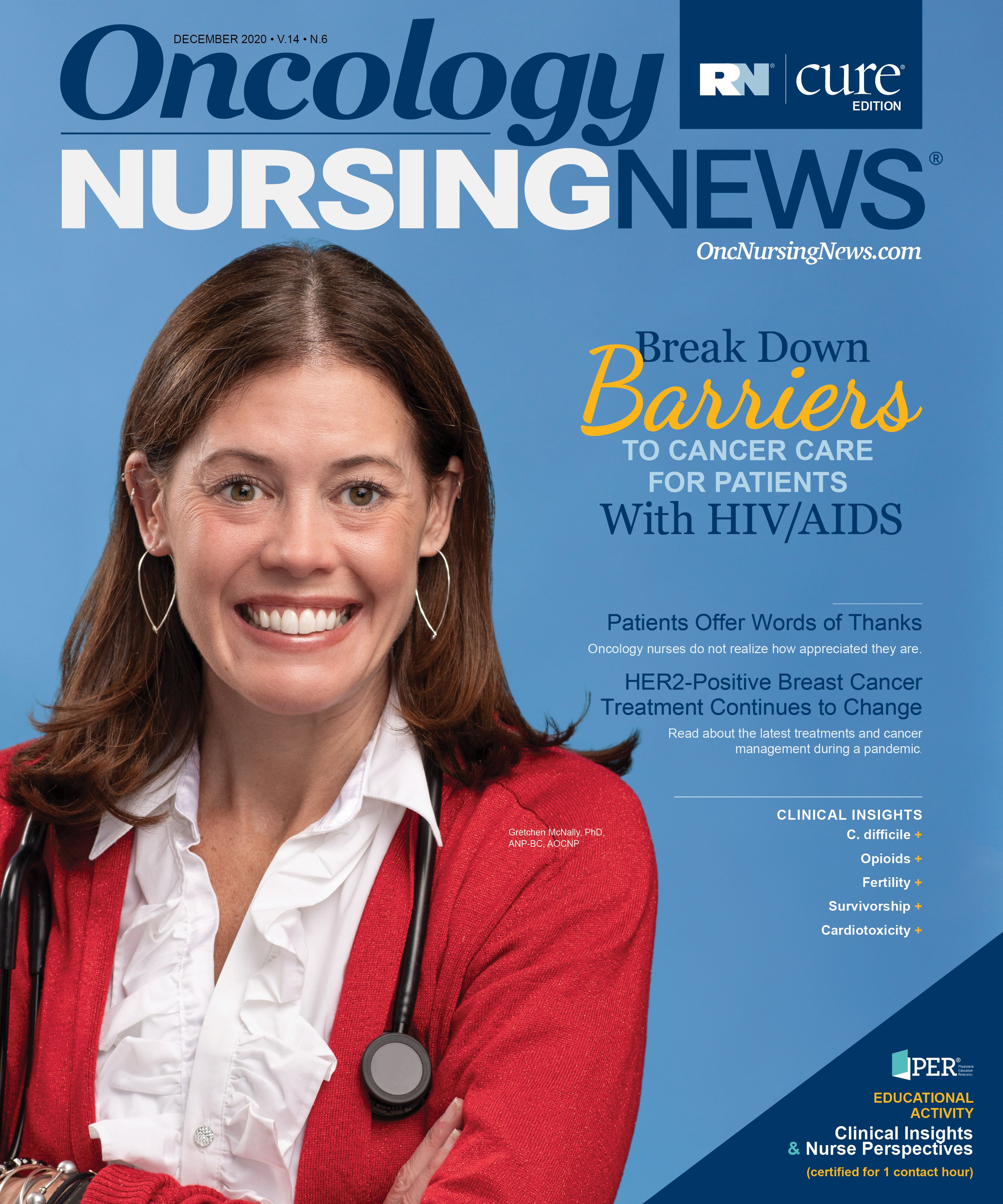Break Down Barriers to Cancer Care for Patients With HIV/AIDS
Nurses can take several steps — from stigma reduction to treatment considerations — to improve the care of patients with cancer who have HIV or AIDS.

Gretchen McNally, PhD, ANP-BC, AOCNP, microspecializes in immunodeficiency- related cancers. - Photo by Jodi Miller
The current coronavirus disease 2019 (COVID-19) pandemic is not the first instance where nurses have found themselves caring for patients with a mysterious and unpredictable disease. In the early 1980s, hospitals around the world began to see patients, primarily young gay men, presenting with severely compromised immune systems, rare cases of pneumonia, and aggressive cases of Kaposi sarcoma, a cancer that causes lesions in the soft tissues.1
At the time, clinicians and investigators had no idea what caused the outbreak, how the virus was transmitted, or how it should be treated. Some referred to the disease as the "gay cancer" or "gay-related immune deficiency." It wasn’t until 1983 that HIV was identified as the cause of AIDS and investigators recognized that HIV could affect anyone.
Today, 40 years after the beginning of the HIV/AIDS outbreak, oncology nurses continue to care for patients with AIDS-related and nondefining AIDS cancers.
Research shows that individuals with HIV/AIDS are at a higher risk of getting certain types of cancer because they have a severely weakened immune system.
Although advancements in antiretroviral medicines now allow those with HIV/AIDS to live longer lives, many of these patients continue to face barriers to cancer care and, in some cases, a stigma that can negatively affect their health outcomes.
Gretchen McNally, PhD, ANP-BC, AOCNP, a nurse practitioner in hematology at The OSUCCC — James in Columbus, Ohio, microspecializes in immunodeficiency-related cancers and says nurses play a critical role in ensuring that patients fighting both HIV/AIDS and cancer receive inclusive services and care.
HOW AIDS-DEFINING AND NON—AIDSDEFINING CANCERS DIFFER
McNally notes that when patients with HIV develop certain types of cancer, their disease has progressed to AIDS.
Gretchen McNally, PhD, ANP-BC, AOCNP, microspecializes in immunodeficiency-related cancers. “These cancers are known as AIDS-defining cancers and include Kaposi sarcoma, aggressive forms of non-Hodgkin lymphoma, and cervical cancer,” she says. “Some patients with HIV are also more likely to develop non—AIDSdefining forms of cancer, but these forms of cancer don’t indicate that their condition has progressed to AIDS.” McNally adds that non–AIDS-defining cancers include head and neck cancer, anal cancer, lung cancer, liver cancer, and Hodgkin lymphoma.
“While AIDS-defining cancers have decreased with effective combination antiretroviral therapy, non—AIDS-defining cancers have increased and account for more than half of all HIV malignancies,” McNally says. “Because people with HIV have a compromised immune system, they’re also more at risk of viruses that can lead to cancer such as the human papillomaviruses [HPV].”
HPV is linked to cancers of the penis, anus, vagina, vulva, mouth, and throat. Although advances in antiretroviral therapy have resulted in HIV being treated as a chronic health condition, McNally says because those with HIV/AIDS are living longer, their increased life span also increases their risk of developing cancer. Approximately 1.2 million individuals in the United States are currently living with HIV.2
ERASING THE STIGMA THROUGH EDUCATION
Although it’s been more than 40 years since health care professionals first treated cases of HIV and AIDS, stigma and discrimination still persist in health care. In 2018, the Centers for Disease Control and Prevention released a review analyzing HIV-related stigma by health care providers.3 Among their findings, investigators reported that stigma can be manifested through inadvertent behaviors and beliefs, including homophobia, transphobia, racism, and negative views of people who use drugs.
“The solution to reducing any stigma is education,” says McNally, who has seen the stigma of HIV transcend to both health care providers and patients.
“Some patients suffer from depression because they believe an HIV diagnosis was their fault,” McNally says.
To fully understand the needs of their patients with HIV/AIDS and help reduce the stigma, McNally says, health care providers must expand their knowledge on issues such as sexual orientation, gender identity, and racial disparities. Although the United States has a policy goal of eradicating HIV by 2030, disparities in HIV care continue to exist.
LUNG CANCER AND HIV
“We’ve been seeing more cancers, including Hodgkin lymphoma and lung cancer, in younger patients,” McNally says. Statistics show that lung cancer is already a leading cause of death in those with HIV, particularly among individuals who smoke, and it is projected to become the most common cause of cancer in individuals with HIV by 2030 if current trends continue.4
To combat rising rates and help patients with HIV reduce their cancer risk, McNally says, health care providers should emphasize prevention and address risk factors. Nurses can do the following:
• Recommend smoking cessation programs to those with HIV to possibly reduce their risk of lung cancer and other tobacco-related diseases.
• Educate patients on the importance of regularly taking their HIV medications. Maintaining a higher CD4+ T-cell count can reduce the risk of AIDS-related cancers.
• Encourage patients to get the HPV vaccine. “The vaccine has been shown to prevent anal and cervical cancers,” McNally says.
TREATMENT CONSIDERATIONS FOR PATIENTS WITH HIV/AIDS AND CANCER
In 2018, a team of health care providers gathered to create new National Comprehensive Cancer Network (NCCN) treatment guidelines to ensure individuals with HIV who also have cancer receive safe and necessary treatment.
Piera Wong, MS, RN, AOCNS, an oncology clinical nurse specialist at Zuckerberg San Francisco General Hospital and Trauma Center and an assistant clinical professor at the University of California, San Francisco, says nurses and physicians at her facility continue to follow these guidelines.
“We have a board-certified oncology pharmacist review all proposed cancer therapy and antiretroviral medications to ensure there aren’t any drug[-drug] interactions,” Wong says. “We also follow patients closely from diagnosis to treatment through survivorship.”
Wong stresses that nurses should also address preventive care with patients, encouraging patients to adhere to annual screenings such as colonoscopies, pap smears, and skin cancer checks.
Ensuring that patients with HIV have access to appropriate cancer care is also a priority. One recent study found that individuals living with HIV have lower rates of cancer treatment, which may contribute to worse survival rates in certain cancers. The study also found that barriers to care sometimes include low income, no insurance or underinsurance, employment instability, lack of social support, and HIV-related stigmas.5
Yet even with appropriate treatment, Wong says, some patients with both HIV and cancer experience poor outcomes. A study published in JAMA Oncology found that outcomes for patients over age 65 with HIV and cancer were significantly poorer than patients who were the same age and HIV negative. The study suggested the higher mortality risk was because of immune suppression.6
“This is one reason why it’s so important to allow [patients with] HIV to enroll in clinical trials,” McNally says.
Although patients with HIV were excluded from cancer clinical trials in the past, that appears to be changing. Last year, a study conducted at Fred Hutchinson Cancer Center in Seattle, Washington, found that patients with HIV and cancer might be successfully treated with the immunotherapy drug pembrolizumab (Keytruda).7
Last year, the National Cancer Institute issued new guidelines for patients with HIV and clinical cancer trials. The guidelines state that individuals who are HIV positive should not be arbitrarily excluded from clinical trials.
The guidelines state that “with effective antiretroviral therapy, individuals with undetectable HIV viral loads by standard clinical assays should generally be considered eligible for a study should they meet all the other eligibility criteria of the trial.”8 “The hope is these new guidelines will ensure all [patients with] cancer who are HIV positive can achieve the same outcomes as those without HIV,” McNally says.

Innovative Program Reduces Nurse Turnover and Fosters Development
Published: September 12th 2024 | Updated: September 12th 2024The US Oncology Network (The Network) has developed one of the most comprehensive programs in the nation to support the professional development and retention of new oncology nurses.






